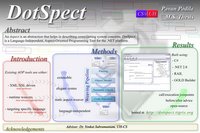Poster Competition
On April 10th, the CS dept. at UH organized a Poster Competition for all CS students. The theme for the posters was the current research that was underway in various labs. My advisor asked me to send my Thesis for the entry. This gave me an opportunity to bring up Expression Graphic Designer (March '06 CTP) to design the poster. It is always fun to use EGD.I spent about 2 days designing the poster and had a couple of reviews with my advisor. The size of the poster was 3 ft x 2 ft. We had setup a Subversion server wherein I would checkin the rendered poster (a .PNG file) and my advisor would pass on his comments in a text file.
Once we reached consensus on the content and layout, I started tweaking it with different combinations of colors, brushes, strokes, etc. For the review, I used to render the poster at 72 DPI (which takes about a minute). However for printing it, I had to render at a minimum of 300 DPI and preferably at 600 DPI. I started with 600 DPI but soon realized that it was going to take forever to render it. Plus EGD used to crash halfway into the rendering process. When I rendered at 300 DPI, it took about 45 minutes, which was reasonable. So for my testing purposes, I decided to stick to 72 DPI (which is good enough to view on-screen).
I even tried exporting the XPR file to Adobe Illustrator and Adobe PhotoShop but that resulted in corrupted files. When exporting to PDF, the live effects were lost, especially the drop-shadows. So I had to stick with PNG, which was the most faithful. The only problem is that rendering a PNG takes much longer than the other export options.
Here is that poster:
Results of the Competition - Not yet declared. [Will be updated]
(In all there were 32 submissions and mine was #12 in the list.)
